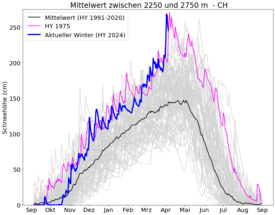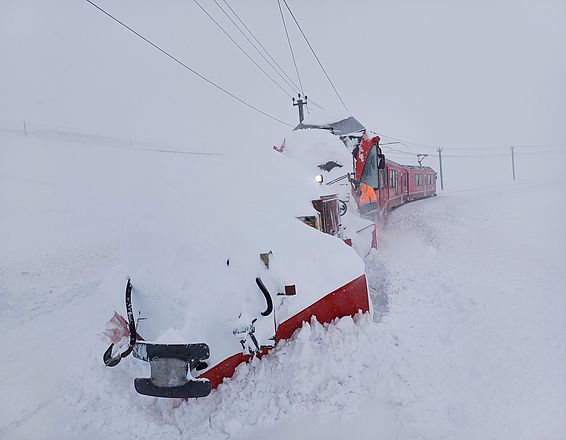05.04.2024 | Jochen Bettzieche | SLF News
The winters of 1974/75 and 2023/24 show surprisingly striking similarities at the beginning of April - in terms of snow depth and avalanche conditions.
This text was automatically translated.
At the beginning of April 1975, numerous avalanches occurred in Switzerland, killing ten people in buildings and causing major damage to settlements, infrastructure and protective forests. SLF climatologist Christoph Marty has observed great similarities between the development of snow depth in the current 2023/24 season and the development 49 years ago: "If we compare the amount of snow that has fallen in the winter months, the curves run parallel over long stretches." (see graph) This is particularly true for the past few weeks. Then, as now, 230 to 270 centimetres of fresh snow fell within six days. However, a larger area was affected in 1975. The zero degree line was significantly lower, so that at that time, for example, around 200 centimetres of fresh snow were measured at 1200 meters in Disentis. This year it was only 29 centimetres in the village itself. Further up in the Lukmanier Pass region at 2555 meters, however, measuring stations recorded around 280 centimeters of snow.

It is not yet clear why the winters in spring are so similar in altitude. "I was surprised myself," says Marty. The only thing that is certain so far is that it doesn't matter that the 2023/24 season was significantly warmer. "At 2500 m, the temperature plays a subordinate role in the amount of new snow, as it is usually cold for snowfall in winter," explains the scientist. He will now take a closer look at the data to find the reasons for the parallels.
In both winters, the avalanche risk was high at the beginning of April. The avalanche bulletin of April 6, 1975 refers to a "critical avalanche situation in individual parts of our Alps". At that time, warnings were not yet issued with the danger levels that apply today. Last Easter weekend, the avalanche danger in the affected areas reached level 4 (high). However, in view of the protective measures taken since the 1970s and the limited snow in the run-out zones, the first few days of April this winter were much less dangerous for people, animals and infrastructure.
Avalanche bulletins of April 5 and 6, 1975
5.April 1975: Today, Saturday, the mountains on the southern side of the Alps, the Goms, the Gotthard region and the Vorderrheintal-Rheinwald-Julier-Oberengadin area received another 50-100 cm of fresh snow. With a total of 80-120 cm of fresh snow in the last three days, there is a high general avalanche risk in these regions, which requires comprehensive protective measures for endangered zones.
In the Saas Valley and the Simplon region, in the Glarus Alps as well as in central Grisons and the central Engadine with fresh snow totals of 40--50 cm, there is a pronounced risk of slab avalanches above around 1500 m, whereby larger avalanches can also break loose spontaneously.
In the rest of the Alps, the accumulation is less than 40 cm. The local danger of slab avalanches continues there. It is to be noted above around 1600 m and especially on slopes generally sloping to the north and east.
6.April 1975: The critical avalanche situation in some parts of our Alps has by no means been resolved. Numerous avalanches have gone downhill and rising temperatures have contributed to a partial settling and consolidation of new snow. On the other hand, another 40-70 cm of snow fell today (Sunday) in the high-risk regions of the south side of the Alps, the Goms, the Gotthard region and in the Grisons Alps, Vorderrheintal-Vals-Rheinwald-Julier-Oberengadin. Stormy winds from southerly directions have also resulted in extensive drifting. The high avalanche risk therefore continues in the regions mentioned, especially in the generally northern and eastern exposed catchment areas.
In the rest of the Alps, the amount of fresh snow is less than 30 cm. There is still a significant snow slab danger above around 1500 m, especially on steep slopes to the north and east.
(Source: SLF Winter Report 1974/75, only in German)
Contact
Copyright
WSL and SLF provide image and sound material free of charge for use in the context of press contributions in connection with this media release. The transfer of this material to image, sound and/or video databases and the sale of the material by third parties are not permitted.
